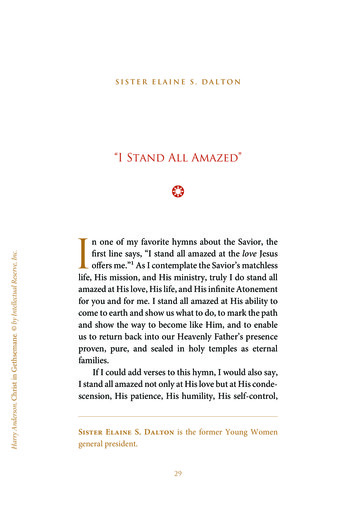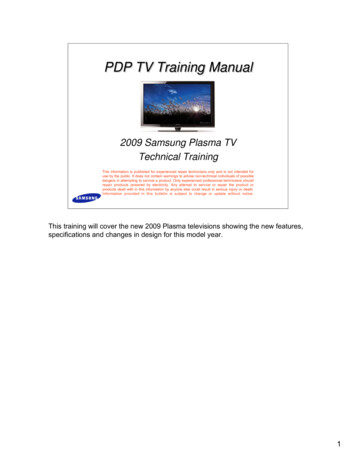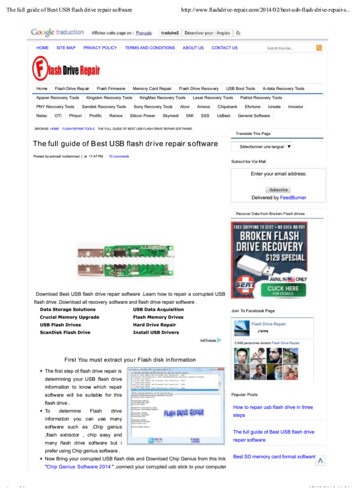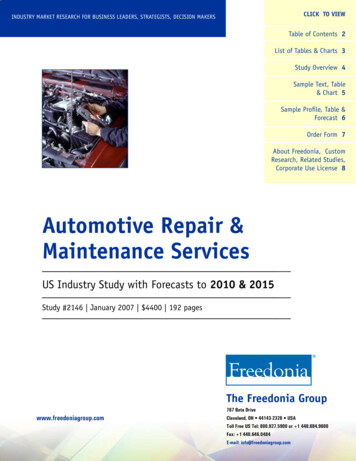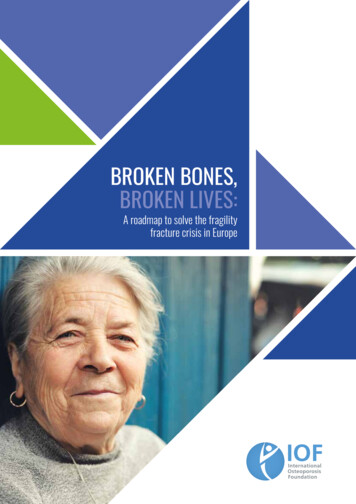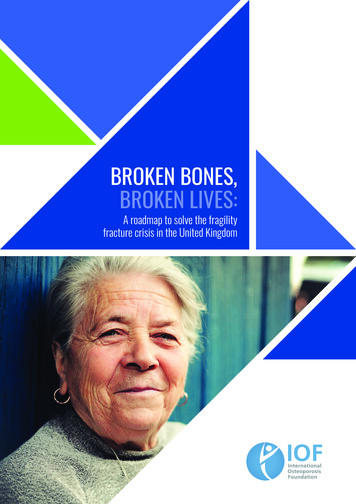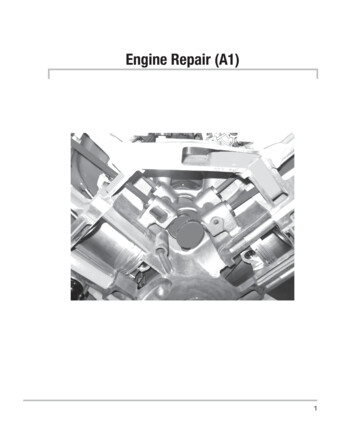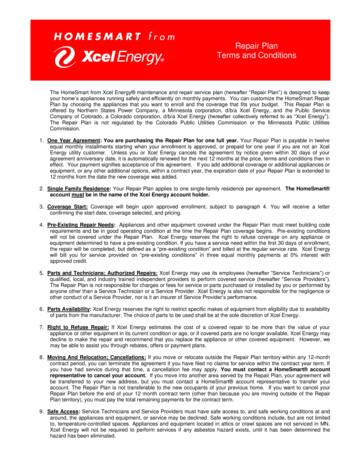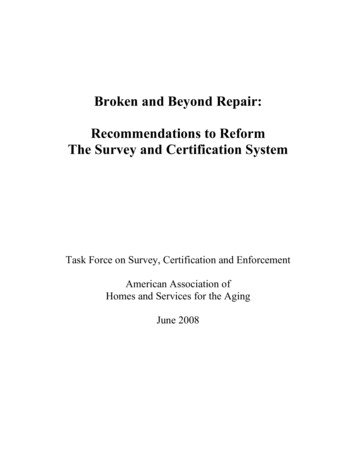
Transcription
Broken and Beyond Repair:Recommendations to ReformThe Survey and Certification SystemTask Force on Survey, Certification and EnforcementAmerican Association ofHomes and Services for the AgingJune 2008
Members of the Task ForceRonald L. BarthPresident/CEOPennsylvania Association for Non-profitSenior ServicesMechanicsburg, PADavid B. BuckshornPresident/CEOWesley Commons Retirement CommunityGreenwood, SCMargaret ChamberlainKitch Drutchas Wagner Valitutti & Sherbrookand The Michigan Association of Homesand Services for the AgingLansing, MILinda DawsonReinhart Boerner Van Deuren S.C.Madison, WILiza FritchleyVP, Senior ServicesWest Georgia Health SystemLaGrange, GABonnie Gauthier, Co-ChairPresident & CEOHebrew Health Care, Inc.West Hartford, CTGary F. GilmoreExecutive DirectorWiley MissionMarlton, NJDemi HaffenrefferPresidentHaffenreffer and Associates, IncPortland, ORPatricia KapsarVice President/Corporate Compliance OfficerBethesda Health Group, Inc.Saint Louis, MOMartha M. KutikPresident/CEOJennings Center for Older AdultsGarfield Heights, OHK.J. LanglaisCEOJohnson County Nursing Center/GERTI(Geriatric Education Research and TrainingInstitute)Olathe, KSMark LenhardPearl Nordan Care CenterJuliette Fowler HomesDallas, TXConnie S. MarchPresident and CEOProvena Senior ServicesMokena, ILLinda O’NeillExecutive DirectorFranciscan Communities, IncCrown Point, INDana PetrowskyPresident/CEOIowa Association of Homesand Services for the AgingWest Des Moines, IABrian L. RobareNursing Home AdministratorThe Estates at CarpentersLakeland, FL2
G. Neil RobertsSchuylerville, NYLynn StarkovichCEOWalker Methodist, Inc.Minneapolis, MNKeli SwalesExecutive DirectorSan Joaquin Gardens Retirement CommunityFresno, CATimothy L. Veno, Co-ChairPresidentKentucky Association of Homesand Services for the AgingLouisville, KYProject StaffAAHSA StaffCory KallheimKaryn DownieBarbara ManardIrene MercerEvvie MunleySusan WeissEditor/WriterGeralyn Magan3
Table of ContentsPageOverview. 5The Task Force and Its Work . 6Short Term Remedies . 15A Vision for a Transformed Survey and Certification System . 17Conclusion . 65AppendicesA. Members of the Task Force—Brief Overview of Experience. 66B. Summary of TF Interviews with State Agency Staff, June 2007 . 75C. Comparison of State Surveyor Position Descriptions. 85D. State IDR Processes . 914
OVERVIEWThe current survey and certification system is broken and beyond repair. The AAHSATask Force on Survey, Certification and Enforcement agrees with the basic vision behindthe “OBRA ’87” legislation, which launched the current survey process. We applaud thethoughtful effort, taken more than 20 years ago, to create an oversight system that strivesto ensure “sustained compliance” of nursing homes with a set of carefully designedregulations and, at the same time, attempts to foster a high quality of care and highquality of life for residents who live in these homes. While these two goals are laudable,the original vision of OBRA has been lost and the current system does not meet either ofthese objectives.Only bold action can remedy this situation. Therefore, the Task Force calls on AAHSA tofacilitate the creation of a broad-based national coalition of organizations, agencies andindividuals who have a stake in the nation’s survey and certification system. Thatcoalition should call for a bold, national reexamination of the process of oversight fornursing facilities. An objective and widely respected organization, such as the Institute ofMedicine, should guide this reexamination process, which should tap the creative ideasand the expertise of individuals in a variety of fields. The national reexamination shouldstrive to create a common vision for how our nation should care for its frailest citizensand should recommend a new oversight model for ensuring that this vision becomesreality in every nursing home in the country.To improve the effectiveness of the current survey system until it can be redesigned, theTask Force also proposes 31 recommendations for immediate AAHSA advocacy. Theserecommendations outline action that AAHSA should take to help the Center for Medicareand Medicaid Services improve the quality of survey teams; foster effectivecommunication among regulators, surveyors and providers; better ensure consistentapplication of regulations; encourage providers to strive for excellence; facilitate accuratereporting to consumers; and improve the fairness of enforcement and dispute resolution.5
CHAPTER ONE:The Task Force and Its WorkAAHSA members’ widespread anger and acute frustration with the current survey andcertification system – regarded by many to be complicated, inconsistent and ineffective –was the primary impetus for creating the association’s Task Force on Survey,Certification and Enforcement in late 2006. In addition, several related developments inthe field of long-term care made an examination of the current oversight systemparticularly timely.Just as Task Force members were being appointed, the Center for Medicare and MedicaidServices (CMS) was concluding its own decades-long experiment to reform the surveysystem through implementation of a new model called the Quality Indicator Survey(QIS). AAHSA members were hopeful that the QIS would significantly improve thesurvey process by increasing its accuracy and efficiency, reducing its onerous nature andsubstantially improving consistency. They, along with CMS, anticipated that the QISwould be implemented broadly if the survey model’s demonstration phase wassuccessful. The association and its members were eager to have the Task Force monitorthe progress and evaluate the impact of this promising new survey model.AAHSA has always supported nursing home oversight and has spearheaded its ownefforts to educate consumers so they are better able to make wise care choices. In light ofthese ongoing commitments, it had a strong desire to participate actively in any nationalconversation about oversight and reporting, and to make sure that conversation took placein the context of fairness and accuracy.Faced with these opportunities and challenges, AAHSA charged the Task Force onSurvey, Certification and Enforcement with four duties:6
1. To articulate specific issues related to the survey and certification system andthe origins of those issues, including public reporting of survey data.2. To identify short-term and long-term solutions to the issues and problems thusidentified.3. To develop strategies for implementing these short- and long-term solutions.4. To identify enforcement issues and develop strategies for resolving problems.The Task Force ProcessAAHSA chose 20 individuals, who have extensive experience with and knowledge of thesurvey system, to serve on the Task Force. Collectively the Task Force members haveover 400 years of experience in the field (see Appendix A for brief descriptions of theTask Force members’ experience). These members were recruited from the highestlevels of their organizations and included presidents and chief executive officers ofAAHSA-affiliated state associations, skilled nursing facilities, continuing care retirementcommunities, regional health and/or geriatric care systems, geriatric education andtraining institutes and law firms. Several members of the Task Force had previouslyserved with state survey agencies as members of survey teams and in other capacities,including State Agency Director.AAHSA made a deliberate effort to ensure that the Task Force was as diverse a group aspossible. Recognizing that survey issues are national issues, members were recruitedfrom 18 states in every region of the country, including Pennsylvania, South Carolina,Michigan, Wisconsin, Georgia, Connecticut, New Jersey, Missouri, Ohio, Kansas, Texas,Illinois, Indiana, Iowa, Florida, New York, Minnesota and Kentucky. The groupconsisted of an equal number of men and women. Members represented organizationsthat were affiliated with religious groups or denominations as well as organizations withno such affiliations.7
While the bulk of the Task Force’s work took place during seven multi-day meetings heldover 14 months, members also worked in small groups, between meetings, to explorespecific aspects of the survey system. Every facet of the group’s work was supported bythorough fact-finding initiatives, including a review of the literature by Task Forcemembers, testimony of experts who offered presentations during Task Force meetings,and original research conducted by individual Task Force members and AAHSA staff.Through those research efforts, the Task Force sought the input of AAHSA-affiliatedstate associations as well as representatives of state survey agencies in seven states, whowere interviewed in June 2007. The Task Force also conducted surveys among a varietyof stakeholders on such topics as the Informal Dispute Resolution process andqualifications for survey personnel. (See the Appendices for results of these specialsurveys.)The Task Force relied on all of these resources, as well as its own experiences with thesurvey system, to develop a cohesive understanding of the challenges that the currentsystem poses to all its participants. It then assessed the system’s capacity to ensure thatnursing homes comply with federal regulations and provide the highest quality of careand services.A Flawed SystemWhen Task Force members arrived in Washington, D.C. in February 2007, for their firstmeeting, it quickly became abundantly clear why providers were so angry and frustratedwith the survey system. Task Force members brought to that first meeting a plethora ofpersonal stories about the survey process – stories that were hauntingly similar, givenmembers’ geographic diversity. Hailing from such distant and diverse states as Floridaand Wisconsin or Ohio and Oregon, providers described in detail the dilemma they facedat least annually when surveyors appeared at the doors of their nursing homes. Despitetheir deliberate and ongoing efforts to provide high-quality care and services to theirresidents – efforts that were often mandated by the mission statements guiding their8
organizations – these providers found themselves, year after year, embroiled in negativeand adversarial encounters with surveyors who seemed bent on “finding somethingwrong.” By the end of each survey, providers reported that they were frequently angryand fed up – and their staffs were demoralized and ready to quit.Punishment, not quality improvement. The adversarial atmosphere created during manysurveys seemed particularly difficult to accept for providers who have always believedstrongly in the value of an effective oversight system. Clearly, the majority of nursinghome facilities are not resistant to government oversight. On the contrary, many of thesefacilities are already involved in long-standing initiatives to monitor and improve thequality of their own care and fully recognize the importance of productive externalevaluation. Sadly, what the current survey offers instead is a complex and punitiveprocess that often resembles an interrogation rather than an effective communicationbetween surveyors and providers, and leaves facility staff members feeling as if they havebeen deemed guilty of negligence until they can prove otherwise.Providers are not the only ones who would prefer a survey system that—whilerecognizing the role of compliance determination and enforcement-- is more productivelypositive and collaborative, rather than relentlessly critical and adversarial. High-levelstaff working in survey agencies in seven states, who were interviewed in June 2007, byTask Force members and staff of relevant state affiliates, overwhelmingly supported amore consultative role for their survey teams (see Appendix B). Staff in several statesrecommended that consultation be built into the survey system, either by schedulingregular consultation visits by surveyors or by mandating ongoing consulting for poorperforming facilities. One survey staff member summed up his colleague’s comments bysuggesting, “providers could learn strategies from surveyors if a consultative process waspermitted.”Complexity breeds inconsistency. The punitive nature of the typical survey is furtheredby extensive and highly detailed regulatory guidelines that challenge both surveyors andproviders. In one of the very few objective, scientific evaluations conducted on the9
implementation of one of these numerous guidelines—the revised federal guidance forincontinence care—researchers found substantial problems among both survey teams andnursing home staff and concluded “The revised guidance will be unlikely to improve thequality of urinary incontinence care in nursing homes.”1 This overwhelming complexityis exacerbated by the fact that no standardized qualifications or training requirementsexist to ensure that surveyors have the knowledge and skills they need to fully understandthe system and its requirements or to conduct objective surveys. For their part, statesurvey agencies also seem troubled by the nature of the survey system they are chargedwith implementing. Survey staff interviewed in the 7-state sample expressed frustration atbeing saddled with a process that is developed and/or periodically changed by federalregulators who have little or no survey experience. Some state employees lamented thefact that process changes are not field-tested by providers and surveyors beforeimplementation. Others said they were challenged by requirements that they carry outnew survey tasks without additional funding. Many agency staff members called forincreased flexibility so they could use their limited survey resources where they felt theycould be most effective–i.e., in troubled facilities in need of close oversight andintervention.Not surprisingly, providers observed that inadequately prepared and overtaxed surveyorstend to make subjective assessments of facility operations – assessments that are oftenbased on the surveyors’ own, idiosyncratic interpretation of CMS guidelines, rather thanthe regulations themselves. The result is an alarming inconsistency in how surveyorsinterpret and apply requirements and cite deficiencies. This perception is supported by anumber of independent evaluations of the system, in which analysts confirm substantialinconsistencies in rule application and call for various solutions to the problem.2,3,4,5,61Catherine DuBeau, Joseph Oustlander, and Mary Palmer. 2007. “Knowledge and Attitudes of NursingHome Staff and Surveyors about the Revised Federal Guidance for Incontinence Care,” The Gerontologist,47:4.2Institute of Medicine. 2001. Improving the Quality of Long-Term Care. Washington, D.C.: NationalAcademy Press.3Walshe, K. 2001. “Regulating U.S. Nursing Homes: Are We Learning From Experience?” Health Affairs,20:6.4Walshe, K. and Harrington, C. 2002. “Regulation of Nursing Facilities in the United States: An Analysisof Resources and Performance of State Survey Agencies.” The Gerontologist, 42:4, 475–486.10
One recent study, for example, concluded that state-by-state differences in the patterns ofdeficiency citations could not be blamed on underlying differences in quality:“ [T]he average facility in California was cited for about 13 violationsin 2004, but only about five percent of facilities in the state were citedfor causing actual harm or immediate jeopardy. On the other hand, NewHampshire averaged only a bit more than five deficiencies per facility,but more than 15 percent of facilities were cited for causing actual harmor placing patients in immediate jeopardy. While there may be somedifference in the absolute underlying level of quality of facilities in thesetwo states, it is unlikely that this difference is sufficient to fully explainthe different patterns of deficiency citations”7Provider comments to the Task Force provided additional, albeit anecdotal, evidence thatsurveyor inconsistency and subjectivity can also plague individual facilities. Theseproviders told stories about specific facility practices, unchanged from one year to thenext, which were essentially approved by one survey team and cited as deficient by thenext team. While the Informal Dispute Resolution (IDR) process is intended to helpproviders question such deficiencies, many providers who have used the IDR processcharacterized it as a “kangaroo court” that values expediency over fairness, frequentlydenying providers the opportunity to fully present relevant evidence or information.Some survey agency staffers in the states where we conducted interviews agreed that theprocess is often marred by a loose structure and an inability to change the scope andseverity of deficiencies.85Winzelberg, G.S. 2003. “The Quest for Nursing Home Quality.” Archives of Internal Medicine, Nov. 24,2003.6Miller, E.A. and Mor, V. 2008. “Balancing Regulatory Controls and Incentives: Toward Smarter andMore Transparent Oversight in Long-Term Care.” Journal of Health Politics, Policy and Law, 33:2, April2008.7Ibid.8The IDR process varies from state to state. See Appendix D for a summary.11
Inconsistency signals deeper flaws. At the outset, Task Force members identified lack ofconsistency as one of the most corrosive features of the current survey system and beganto explore steps that might help improve the situation. However, the more Task Forcemembers examined the root causes of these inconsistencies, the more they becameconvinced that incremental changes would only contribute to a modest amelioration ofthe problem. The Task Force came to believe that the system’s lack of consistency is onlyone symptom of fundamental flaws in the structure of the survey system. Essentially,these flaws guarantee that neither nursing homes nor surveyors can succeed within thesystem because, in the words of Dr. Jack Schnelle of Vanderbilt University, that systemis built on mythology.According to Dr. Schnelle, a professor in Vanderbilt’s School of Medicine and a staffmember at its Center for Quality Aging, the survey system inevitably leads toinconsistent results and poor feedback regarding real quality issues because it ischaracterized by:“unrealistic expectations about how many recommended care processescan be measured; poor definition of measures and methods ofmeasurement; confusing rules linking measures to deficiencystatements; and a survey culture that depends on expert judgment.”9The Interpretive Guidelines – the extensive CMS guidance to surveyors contained in theState Operations Manual (SOM) that attempts to clarify and/or explain the intent ofregulations – stands at the heart of the survey system. The publication contains page afterpage of discussion about quality care processes. Dr. Schnelle’s research shows that,despite all of this “guidance,” nursing homes find it virtually impossible to carry out allof the recommended processes. Likewise, surveyors continually fall short in theirattempts to measure compliance systematically.9Schnelle, J.F. 2007. Presentation to Task Force on Survey, Certification and Enforcement.12
During a presentation at one Task Force meeting, Dr. Schnelle outlined several steps hebelieves would fundamentally reshape the survey system to address these problems. Hisrecommendations call for using the existing Interpretive Guidelines to develop and teststandardized investigative protocols that would focus on a realistic set of qualitymeasures. Dr. Schnelle emphasized that sufficient resources must be allocated toimplement the protocols, which must be communicated clearly to nursing home staffs toobtain consensus.While the Task Force did not specifically incorporate Dr. Schnelle’s formula forreforming the survey system into its recommendations, the group found his analysiscompelling and is convinced that creative thinking and solid research like his should playan integral role in any serious effort to reform the survey process.Regulations and quality improvement. In addition to concerns about consistentinterpretation of regulations, providers and state survey staff alike also expressed deepconcerns about the substance of some federal regulations governing nursing homes. Forexample, providers who have invested considerable time and energy in culture changeinitiatives often feel thwarted and hamstrung by regulations that either don’t encourage ordon’t allow certain person-centered innovations. In addition, both providers andsurveyors questioned whether enforcement mechanisms associated with the surveysystem are really helping to improve quality of care and quality of life. Survey agencyleaders, in particular, questioned whether written plans of correction brought about realchange or simply added to a facility’s paperwork burden; whether the oversight systemwas overly dependent on fines as the enforcement mechanism of choice; and whether thetwo-year ban on nurse aide training programs triggered automatically under certainconditions of noncompliance encourages quality improvement or actually serves as abarrier to quality improvement.Poor communication. Underlying and aggravating all these problems is the fact thatcommunication between providers and surveyors is often strained during the survey andis virtually nonexistent between surveys. Far from fostering open dialogue as a way to13
achieve superior results, the system’s communication barriers encourage all participantsto be distrustful of one another and to carefully guard their words for fear of open conflictor retribution. State surveyors acknowledged these problems and several describedactions they have taken to improve communication between themselves and providers.These improvements included quarterly meetings between surveyors and providers inIllinois and Connecticut, a Surveyor/Provider Forum in Oregon, and the publication of aregulatory update newsletter (in addition to annual meetings for providers) in Missouri.One Primary RecommendationThe Task Force on Survey, Certification and Enforcement ended its 14-month evaluationof the survey system by coming to a single, striking consensus:The current survey and certification system is broken and beyond repair.Given this consensus, the Task Force decided that it could not offer, as its primaryrecommendation, a collection of incremental “fixes” for the current survey system. Themore the Task Force learned, the more strongly its members believed that the time forthese “fixes” has passed.The Task Force agrees with the basic concept behind the “OBRA ’87” legislation, whichlaunched the current survey system. We applaud the thoughtful effort, taken more than 20years ago, to create a system with two laudable goals: (1) to ensure “sustainedcompliance” of federally-certified nursing facilities with a set of carefully designedregulations; and (2) to foster high quality of care and quality of life for residents who livein these homes.10 However, the original vision of OBRA has been lost and the current10CMS describes its belief about what the current survey measures in the following manner: “ findingsof inspections do not present a complete picture of the quality of care provided by the nursing home. Theinspection measures whether the nursing home meets the minimum standard for a particular set ofrequirements. If a nursing home has no deficiencies, it means that it met the minimum standards at the timeof the inspection. However, this information cannot be used to identify nursing homes that provideoutstanding elated/ImportantInformation.asp?dest NAV Home About NursingHomeCompare#TabTop; accessed June 13, 2008).14
system meets neither goal. Essentially, the system has failed us as providers andregulators, and worse, has failed the frail and elderly people whom we serve.Only bold action can remedy this situation. Therefore, the Task Force on Survey,Certification and Enforcement calls for a broad-based, national effort that will take acompletely new look at the entire survey process and boldly redesign that system so thatit supports and facilitates the original vision on which it was based. Chapter 2 of thisreport describes in more detail the Task Force’s primary recommendation which reads asfollows:AAHSA should facilitate the creation of a broad-based national coalitionof organizations, agencies and individuals who have a stake in thenation’s survey and certification system. That coalition should call for abold, national reexamination of the system that provides oversight ofnursing facilities. An objective and widely respected organization, suchas the Institute of Medicine, should guide this reexamination process,which should tap the creative ideas and the expertise of individuals in avariety of fields. The national reexamination should strive to create acommon vision for how our nation should care for its frailest citizensand should recommend a new oversight model for ensuring that thisvision becomes reality in every nursing home in the country.Short-Term RemediesA national reexamination of the survey system will not be an easy task. It will take time,energy and resources to complete. In the meantime, providers and surveyors continue tostruggle within a dysfunctional system. Eager to offer these providers some relief, and toimprove the effectiveness of the current survey system until it can be redesigned, theTask Force also proposes 31 recommendations for immediate AAHSA advocacy in sixcategories. These recommendations outline action that AAHSA can take to help CMSimprove the quality of the survey team; foster effective communication between15
regulators, surveyors and providers; ensure consistent application of regulations;encourage providers to strive for excellence; facilitate accurate reporting to consumers;and improve the fairness of enforcement and dispute resolution. These recommendationsare described in Chapter 3.16
CHAPTER TWO:A Vision for a Transformed Survey and Certification SystemRecommendationAAHSA should facilitate the creation of a broad-based nationalcoalition of organizations, agencies and individuals who have astake in the nation’s survey and certification system. That coalitionshould call for a bold, national reexamination of the system thatprovides oversight of nursing facilities. An objective and widelyrespected organization, such as the Institute of Medicine, shouldguide this reexamination process, which should tap the creativeideas and the expertise of individuals in a variety of fields. Thenational reexamination should strive to create a common vision forhow our nation should care for its frailest citizens and shouldrecommend a new oversight model for ensuring that this visionbecomes reality in every nursing home in the country.In May 1982, the Health Care Financing Administration (HCFA) – now called theCenters for Medicare and Medicaid Services or CMS – announced a proposal to changesome of the regulations governing the process it used to certify the eligibility of nursinghomes to participate in Medicare and Medicaid. HCFA proposed its changes in responseto provider complaints that regulations were unreasonably rigid. If implemented asproposed, the changes would have eased the annual inspection and certificationrequirements for facilities with a good record of compliance and authorized states toaccept accreditation of nursing homes by the Joint Commission on Accreditation ofHospitals.Consumer groups and most state regulatory agencies opposed the changes because theyfelt, among other things, that HCFA’s reforms did not address fundamental weaknessesin the regulatory system. The outcry was loud enough to force a delay in theimplementation of HCFA’s proposal and for HCFA to ask the Institute of Medicine17
(IOM) to undertake a study that would “serve as a basis for adjusting federal (and state)policies and regulations governing the certification of nursing homes so as to make thosepolicies and regulations as appropriate and effective as possible.” The IOM report,entitled Improving the Quality of Care in Nursing Homes,11 was widely respected when itwas released in 1986 and many of its recommendations were incorporated into thelandmark 1987 legislation – now commonly referred to as “OBRA ’87 – which broughtsweeping changes to nursing home operations.OBRA put residents in the forefront of the survey and certification system, guaranteeingthem certain rights and ensuring that they could have a voice in decision making abouttheir treatment and the way they lived their lives. Most significantly, the legislationshifted the focus of regulatory oversight from facilities’ capacity to provide care – that is,its “paper compliance” with regulations – to a focus on the actual care provided. OBRAfocused needed attention on systematic, multi-disciplinary assessments and care-planningand provided critical tools to accomplish this. The statute provided a framework forcollecting, electronically transmitting, analyzing and disseminating potentially useful andnationally standardized information on patient progress and outcomes. The vast andenduring reduction in the use of physical and chemical restraints on nursing homeresidents remains one of the legislation’s most significant accomplishments.OBRA ’87 also transformed the government’s system of enforcing its regulations. Thelegislation placed an emphasis not merely on punishing and closing poor-performingfacilities, but on implementing a process that would help those facilities achieve“sustained compliance
The current survey and certification system is broken and beyond repair. The AAHSA Task Force on Survey, Certification and Enforcement agrees with the basic vision behind . reality in every nursing home in the country. To improve the effectiveness of the current survey system until it can be redesigned, the
